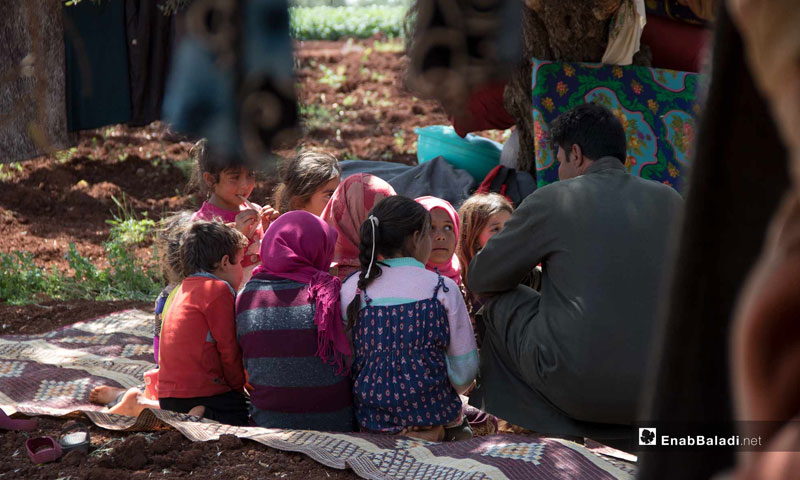Idlib – Mohammad al-Smaih, a high school student in southern rural Idlib, has been cut off from school about two months ago, for he and his family escaped the aerial and missile bombing by the Assad forces and Russia which has been targeting the majority of the governorate’s areas under the military campaign it has been witnessing since February.
Talking to Enab Baladi, Mohammad said that he has been taking classes outside the school in southern rural Idlib, which suffered a focused bombardment bringing the educational process to a complete halt. For the same reason, the students refrained from going to school, fearing all sorts of affliction.
The suffering does not stop at this point, for the fleeing students are facing massive difficulties and obstacles in the areas they were displaced to, particularly because they are supposed to undergo the national exams of upper-secondary and basic education in no time.
Student Mohammad today lives with his family under the olive trees in an area near the Syrian-Turkish borders. He said that displacement has largely affected education and prevented a massive number of students from pursuing their education or having the needed focus for whatever they are doing, pointing out that “the displaced persons are many, and there are not enough houses for all.”
In Northern Syria, the Response Coordinators has monitored the schools and educational complexes destroyed by the bombings of the Syrian regime and Russia. Last May, the coordinators reported that the number of schools targeted by the Assad forces and the Russian side in Idlib governorate has amounted to 44 schools from January 1 to May 8, 2019.
The Coordinators added that the destroyed schools are located within the range of the educational complexes affiliated with Idlib Directorate of Education, pointing out that the rates of damage that befell the targeted schools varied between 5% and totally out of service.
Campaign Launched by Idlib Directorate of Education
Driven by the ongoing shelling, targeting the cities and towns of Idlib governorate as far as rural Hama, while sparing neither residential neighborhoods nor schools and educational complexes, Idlib’s Directorate of Education has launched a campaign called “We Are Continuing,” in a step to shed a light on the educational process in the governorate and the difficulties it is facing in the meantime.
Mustafa al-Haj Ali, the Director of the Education Directorate, said that the latter has started a media campaign, which seeks to elucidate the workings of the Directorate, what it is doing toady and what it will be doing in the upcoming phase, given the approaching exams of high upper-secondary and basic education.
Al-Haj Ali added that there are 25 thousand and 677 high school and basic education students, a massive proportion of whom has been displaced, more than a third.
Half of the total number of students is from the areas suffering extensive aerial and artillery shelling by the Assad forces and Russia.
The Education Directorate has issued a decision earlier on, under which it cancelled the exams of the transitional phase, including students of grades one to four, in Jisr al-Shugur, Ariha and Ma`arat al-Nu`man. Students were, thus, granted the grades of the mid-term exams for each of the exams they did not take.
The Directorate, al-Haj Ali said, has documented the displacement of two thousand students from their areas, where schools were yet operating. It also recorded 68 schools as being targets to the last military campaign which the Syrian regime and Russia are conducting.
Bringing Back Regulatory Work
According to student Mohammad al-Smaih, exam centers, which are to take place in a few days, have not been defined yet, adding that he, as a student, is affiliated with the Educational Complex of Kafr Nabl and is waiting for a decision from the Education Directorate that is to specify the exam location.
Al-Haj Ali added that the educational complexes are still being targeted and the launched campaign has the power to bring regulatory work to basic and upper-secondary school according to international standards, the thing that will guarantee “transparent and fair” exams.
He added that the Directorate’s emergency response committee has posted links onto social networking sites to locate students, in the hope of setting up exam centers soon, amidst expectations that their number will amount to 195 centers, which is also subject to increase.
The links are a means for the Directorate of Education to collect the students’ data and their locations, as to deploy them to exam centers according to their geographical distribution.
“We Are Continuing campaign is the result of the solidarity of the civil society entities, for there is communication with the local councils and all these entities as to help students carry on their exams.”
Al-Haj Ali pointed out to the educational courses being conducted in the safer areas in Northern Syria, which are classified as remedial reading classes, in a move to support the students by offering them with extensive courses.
According to the latest statistics issued by the Response Coordinators in Northern Syria, the number of internally displaced people has amounted to 72520 families, 471413 persons, since the beginning of the military campaign, which Assad forces launched early in February, to June 3.
The Coordinators stated that the numbers of the internally displaced persons are yet being recorded in the various areas and districts that received IDPs, the number of which is 35 districts, starting from northern rural Aleppo, as far as areas in north-western Syria.

